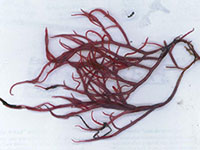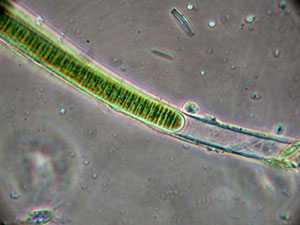Macroalgal Blooms
Dense accumulations of macroalgae (seaweed) have been observed in the DE and MD Coastal Bays as well as some areas in the Chesapeake Bay. They can lead to substantial shading of underwater grasses and low dissolved oxygen events through nocturnal respiration or decomposition. Largely ungrazed, these blooms can also impede recreational boating. Brown algae (pheophytes) are not a dominant type but red and green are abundant.
Rhodophytes, Red Algae
 The Agarh’s Red Weed (Agardhiella tenera) is the dominant species in the MD Coastal Bays with Graceful Red Weed (Garcilaria sp.) second. These two genera are the ‘most characteristic plants in warm bays and sounds south of Cape Cod.’ Red algae are commercially raised and harvested for their agar and carrageenans which are used in the food, cosmetic and medical industry. Gracilaria tikvahiae is often found in areas undergoing eutrophication.
The Agarh’s Red Weed (Agardhiella tenera) is the dominant species in the MD Coastal Bays with Graceful Red Weed (Garcilaria sp.) second. These two genera are the ‘most characteristic plants in warm bays and sounds south of Cape Cod.’ Red algae are commercially raised and harvested for their agar and carrageenans which are used in the food, cosmetic and medical industry. Gracilaria tikvahiae is often found in areas undergoing eutrophication.
Chlorophytes, Green algae
 Green Hair Algae (Chaetomoropha sp.) and Sea Lettuce (Ulva) were the most abundant green macroalgae. Ulva was widespread throughout the coastal bays and present among all seasons. Ulva spp. has been associated with eutrophication. The state of Delaware found Ulva to be so abundant that they initiated a harvesting program to reduce the threat to habitat, depleted dissolved oxygen. Ulva is initially attached, but in later stages of life is free drifting.
Green Hair Algae (Chaetomoropha sp.) and Sea Lettuce (Ulva) were the most abundant green macroalgae. Ulva was widespread throughout the coastal bays and present among all seasons. Ulva spp. has been associated with eutrophication. The state of Delaware found Ulva to be so abundant that they initiated a harvesting program to reduce the threat to habitat, depleted dissolved oxygen. Ulva is initially attached, but in later stages of life is free drifting.
Filamentous Cyanobacteria Mats (bluegreen algae)

Lyngbya spp. is a freshwater, benthic, filamentous cyanobacteria. The wool-like strands often clump together and rise to the surface forming large floating mats. Found in lakes, rivers, springs, and water supply reservoirs throughout southeastern U.S., it is capable of forming thick nuisance blooms during the summer months under optimal growing conditions (24°C and favourable light). It is a problem in Florida where toxins cause skin and gastrointestinal inflammation. In the northern bay it has fouled crab pots, fishing gear and covered seagrass beds.
Planktothrix isothrix is a freshwater, benthic filamentous cyanobacteria. It is a known producer of potent hepatotoxins called microcystins. Commonly observed in lakes, it has bloomed in the non-tidal portion of the Potomac River in Maryland and Lake Anita Louise in the winter of 2016.